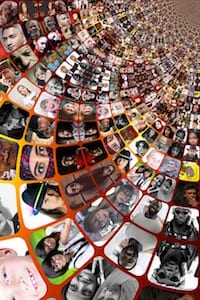Table of Contents
by Ben Cogswell and George Lopez
![]() In the Alisal Union School District, a TK–sixth-grade district with about 9,000 students in Salinas, California, we’re trying to shift the needle of digital citizenship. Over the last five years, we’ve slowly been rolling out our 1-to-1 take-home technology program, starting with one school and moving across the district. Finally, next year, we will be completely 1-to-1. It’s been a long but productive journey making sure students and teachers are using devices positively and productively both at home and at school.
In the Alisal Union School District, a TK–sixth-grade district with about 9,000 students in Salinas, California, we’re trying to shift the needle of digital citizenship. Over the last five years, we’ve slowly been rolling out our 1-to-1 take-home technology program, starting with one school and moving across the district. Finally, next year, we will be completely 1-to-1. It’s been a long but productive journey making sure students and teachers are using devices positively and productively both at home and at school.
During our 1-to-1 rollout, we’ve seen a little bit of everything, from an online clown scare to issues with students bullying each other on social media. Some teachers, administrators, and parents have a reactive approach to digital citizenship, waiting until there’s a problem before taking action. Because of this, our edtech department has been working with teachers, administrators, and parents on viewing digital citizenship in a different light while trying to be proactive, focusing on the positive power of devices. Just as teachers take time at the beginning of the year to review class expectations, focusing on positive expectations when it comes to computer usage and digital citizenship can start students off on the right foot.
Building Capacity
It hasn’t been a straight path to success, and we still have a long way to go. We started with some isolated, one-time digital citizenship trainings during our district professional development days, but they weren’t well attended.  We also offered demo lessons and coaching around digital citizenship but didn’t have a lot of takers. We realized that balancing all the district and site initiatives made it difficult to implement digital citizenship in an effective manner.
We also offered demo lessons and coaching around digital citizenship but didn’t have a lot of takers. We realized that balancing all the district and site initiatives made it difficult to implement digital citizenship in an effective manner.
Furthermore, with only two TOSAs (teachers on special assignment), we realized that we couldn’t get to almost 400 classrooms and teach the concepts of digital citizenship. For that reason, our best option was to build capacity. We decided to take a different approach and support teachers in becoming Common Sense Recognized Educators, along with offering paid time for planning the implementation of digital citizenship in a serial, or ongoing, format. This was the beginning of our #AlisalStrong Digital Citizenship Academy.
With the mantra of “one teacher at a time,” we began rolling out the Digital Citizenship Academy. The overall goal of this program is to give teachers time and space to learn about Common Sense Education’s resources so they can implement the curriculum in their classrooms. Teachers need to learn how to access and teach the curriculum on their own, so we give them the time and space to learn about Common Sense Education.
Bringing the Digital Citizenship Academy to Teachers
We headlined the Digital Citizenship Academy with the Common Sense Recognition program, stressing that teachers can learn how to integrate digital citizenship into the curriculum, have planning and collaboration time, learn how to connect with families, accumulate new resources, and, most importantly, teach students how to be safe, responsible, and ethical online citizens.
Alisal edtech director Joshua Harris said, “Having our teachers become Common Sense Educators is really important. They act as ambassadors carrying the message of the need for digital citizenship education in all of our classrooms. I think moving forward, we need to find a way to raise their profile and visibility among their peers and their site leadership. The more their colleagues see them as boots on the ground, real-life exemplars of this kind of teaching, the more they will see it is not that difficult to bring these lessons to each and every child.”
We based the academy on the Common Sense Educator recognition process. We planned out four non-consecutive days in which teachers could run through the whole recognition process with guidance. We scheduled the trainings two to three weeks apart so teachers would have time to plan and implement lessons and bring back some takeaways and reflections from their classrooms. The training runs through Google Classroom, and you can access the slides we used here (they’re in reverse chronological order). This platform allows teachers a place to question, share, and collaborate.
Our first cohort of teachers in spring of 2017 had 14 educators who made it through all the sessions. Our fall 2017 cohort had 17 teachers, and our third cohort in spring 2018 had 12. We decided to run the trainings twice a year to give teachers more than one chance to participate.
Academy Results
 Many of the teachers who completed our Digital Citizenship Academy tell us they now have a much better understanding of what digital citizenship is and of the different concepts under that umbrella. They also share that they now have a better idea of how to integrate these lessons throughout their teaching since we’re limited by the number of instructional minutes.
Many of the teachers who completed our Digital Citizenship Academy tell us they now have a much better understanding of what digital citizenship is and of the different concepts under that umbrella. They also share that they now have a better idea of how to integrate these lessons throughout their teaching since we’re limited by the number of instructional minutes.
Second-grade teacher Maricar Osorio said, “The Digital Citizenship Academy has been an eye-opener, as it changed the way I interact with the digital world. I am now more aware of appropriate sharing, evaluating [and] validating websites, and communicating online. The way I interact with this world could be productive or destructive. Finally, I can’t pass the knowledge from the academy to my students just telling them but rather through modeling and/or observing the norms.”
From our teacher feedback, we have found the academies to be informative and well liked. The one challenge that we have is that not all the teachers who participated have completed the Common Sense Educator recognition application. However, we do know that all of them taught at least one Common Sense Education lesson and now have a deeper and better understanding of the importance of implementing digital citizenship into their daily instruction.
Author
Ben Cogswell and George Lopez are both classroom teachers at Alisal Union Elementary School District in Salinas, California teaching English Language Arts, Math, Science, Social Studies, Arts, English Language Learning, and Health & Wellness to grades Pre-K through 6th grade. Follow Ben Cogswell on Twitter
Further Reading
- TeachAway – How teachers can bring digital literacy into the classroom
- Education World – Ten Digital Literacy Resources for Teachers
- ResourcEd – Digital literacy in the classroom. How important is it?





